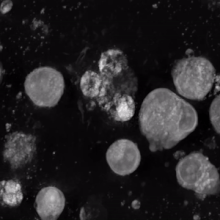
Megakaryocyte/erythrocyte progenitor cells (MEPs), among other blood cells, are generated as a result of hematopoiesis, which occurs in the bone marrow. Hematopoietic stem cells (HSCs) can differentiate into one of two progenitor cells: the common lymphoid progenitor (CLP) and the common myeloid progenitor (CMP). MEPs derive from the common myeloid progenitor lineage.[1] MEPs must commit to becoming either platelet-producing megakaryocytes via megakaryopoiesis or erythrocyte-producing erythroblasts via erythropoiesis.[2][3] Most of the blood cells produced in the bone marrow during hematopoiesis come from MEPs.[4]

- Quality rating: The article is rated stub-class on the project’s quality scale and low-importance on the project’s importance scale.
- These ratings suggest that this article is a good candidate for editing.
- The sources are extremely outdated (2006, 2009).
- This means that the information within the article is likely outdated.
- Up-to-date, reliable articles will be used to update the information within the article.
- The article offers very limited information about megakaryocyte - erythroid progenitor cells.
- This article needs more detail and background information.
- Due to the lack of information, the article has no organization.
- When the article is edited, new information will be organized.
- It will contain an introductory section that provides a broad overview of the topic.
- It will also contain headings and subheadings all organized by certain topics relevant to the topic. The subtopics will not stray too far from the main topic at hand.
- When the article is edited, new information will be organized.
- The article contains only one image, and the one image it does contain is confusing and contains undefined abbreviations.
- The current image will be replaced with one that is easier for a broader audience of people to comprehend.
- Additional images will also be added. Images are a quick and easy way to understand material, so more images (to complement the additional material) could help improve the article significantly.
| This is the sandbox page where you will draft your initial Wikipedia contribution.
If you're starting a new article, you can develop it here until it's ready to go live. If you're working on improvements to an existing article, copy only one section at a time of the article to this sandbox to work on, and be sure to use an edit summary linking to the article you copied from. Do not copy over the entire article. You can find additional instructions here. Remember to save your work regularly using the "Publish page" button. (It just means 'save'; it will still be in the sandbox.) You can add bold formatting to your additions to differentiate them from existing content. |
Article Draft edit
Lead edit
Article body edit
References edit
- ^ Xavier-Ferrucio, Juliana; Krause, Diane S. (2018-08-01). "Concise Review: Bipotent Megakaryocytic-Erythroid Progenitors: Concepts and Controversies". Stem Cells. 36 (8): 1138–1145. doi:10.1002/stem.2834. ISSN 1066-5099. PMC 6105498. PMID 29658164.
{{cite journal}}: CS1 maint: PMC format (link) - ^ Shin, Eunju; Jeong, Jong-Gwan; Chung, Hyunmin; Jung, Haiyoung; Park, Charny; Yoon, Suk Ran; Kim, Tae-Don; Lee, Seung Jin; Choi, Inpyo; Noh, Ji-Yoon (2020-07-12). "The Gata1low murine megakaryocyte–erythroid progenitor cells expand robustly and alter differentiation potential". Biochemical and Biophysical Research Communications. 528 (1): 46–53. doi:10.1016/j.bbrc.2020.04.143. ISSN 0006-291X.
- ^ Soares-da-Silva, Francisca; Freyer, Laina; Elsaid, Ramy; Burlen-Defranoux, Odile; Iturri, Lorea; Sismeiro, Odile; Pinto-do-Ó, Perpétua; Gomez-Perdiguero, Elisa; Cumano, Ana (2021-04-05). "Yolk sac, but not hematopoietic stem cell–derived progenitors, sustain erythropoiesis throughout murine embryonic life". Journal of Experimental Medicine. 218 (4): e20201729. doi:10.1084/jem.20201729. ISSN 0022-1007.
- ^ Psaila, Bethan; Mead, Adam J. (2019-03-28). "Single-cell approaches reveal novel cellular pathways for megakaryocyte and erythroid differentiation". Blood. 133 (13): 1427–1435. doi:10.1182/blood-2018-11-835371. ISSN 0006-4971. PMC 6443046. PMID 30728145.
{{cite journal}}: CS1 maint: PMC format (link)